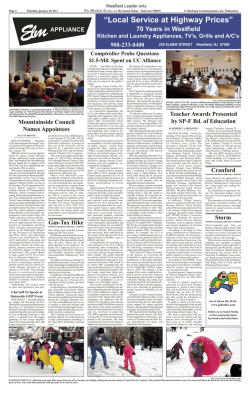
The art of wavefunction visualisation of amplitude and phase from 5
The art of wavefunction visualisation of amplitude and phase Michael Bromley Isaac Lenton School of Maths/Physics The University of Queensland (Martin Kandes Ricardo Carretero San Diego State University) y (osc. units) from 5-D information 4 3 2 1 0 -1 -2 -3 -4 2π π 0 -4 -3 -2 -1 0 1 2 3 4 x (osc. units) 3 vortices y’all AIP 15min talk 2014 Bromley Group @ UQ Computational AMO Physics • Funding for my Future Fellowship comes from http://www.smp.uq.edu.au/people/brom • ultracold atom optics esp. BEC/atom interferometry • atomic structure calculations, atomic clocks such as Al+ • non-linear optics of gases, eg. χ3 (I, ω) • positron-atom interactions, eg. e+ Ca Pre-school • Mum bought me Commodore 64 (64KB RAM) • Coded some BASIC games typed out from books. • Amiga 500 (Motorola 68000 @ 7.09 MHz) 1024 KB RAM • Learnt AmigaBASIC... DIY pictures of fractals etc Movie 1 — Amiga raytracing software • Inspired by, eg. The Amiga Juggler (1986) https://www.youtube.com/watch?v=-yJNGwIcLtw • First played with ray-tracing software Single Particle Wavefunction • The wavefunction, |Ψ(t)i, lies in Hilbert Space • In position-space the wavefunction is complex-valued (hx| ⊗ hy| ⊗ hz|) |Ψ(t)i = Ψ(x, y, z, t) • represented through both an amplitude and (local) phase Ψ (x, y, z, t) ≡ A (x, y, z, t) exp (i ϕ (x, y, z, t)) , • with frozen transverse, Ψ (x, y, z, t) = ψi (z)ψj (y)Ψ(x, t) Ψ(x, t) = (hx| ⊗ hψi | ⊗ hψj |) |Ψ(t)i Z Z = ψi∗ (z)ψj∗ (y)ψi (z)ψj (y)Ψ(x, t) dydz Z Z = Ψ(x, t) |ψi (z)|2 dz |ψj (y)|2 dy = Ψ(x, t) 1-D Probability Density • First computer visualisation of 1-D probability density “Computer-Generated Motion Pictures of One-Dimensional Quantum-Mechanical Transmission and Reflection Phenomena”, Goldberg et al. Am. J. Phys. 35, 177 (1967) 3-D Wavefunctions I • Consider the classic hydrogen (time-indep) eigenstates |Ψnℓm i → Ψnℓm (~r, t) = exp(−iEn t/~)ψnℓ (r)Yℓm (θ, φ) • Consider the three ℓ = 1 and m = −1, 0, 1 • visualise using contours based on probability density http://commons.wikimedia.org/wiki/User:Geek3/hydrogen • warning: two hours to generate each image! Movie 2: 3-D Wavefunctions II • Dauger atom-in-a-box (as seen in QM by Griffiths) • i-thing apps http://daugerresearch.com/orbitals start 2 min mark https://www.youtube.com/watch?v=OkRCnmpxZ4w My computer science philosophy • I’m a true believer in open-source (free-software) • write my code in fortran using blend of OpenMP/MPI. • At UQ we’ve built a (little supercomputer) with 12 Phi • advantage is x86 architecture (also have GPUs/CUDA). Intro to my atom optics research • Consider the (single-particle) Rotating (BEC) NLSE i h ∂ ˆ z + g|ψ(r, t)|2 ψ(r, t) ψ(r, t) = − 21 ∇2 + V (r, t) − ΩL i ∂t • Mean-field treatment with (g ∝ (N − 1) other atoms) • Atoms are trapped eg. in all-optical ring-potential: V(ρ,ϕ,z=0) (osc. units) 20 10 0 -20 -10 x (osc. units) 0 10 10 20 -20 -10 0 y (osc. units) 20 Example: The Sagnac effect • Consider counter-propagating matter-waves in a ring LΩ L+ t>0 t=0 rotating source L− t>0 L− t= τ k/2 |Ω| t= τ k/2 θ=|Ω|τ L+ rotating detector t=0 k t= τ k first collision L− http://arxiv.org/abs/1306.1308 L+ 2-D Wavefunctions Ψ(x, y, t) • Visualisation using fortran → gnuplot → ffmpeg 3-D Wavefunctions Ψ(x, y, z, t) • Goal: HD-quality 3-D animations of 3-D wavefunctions • using fortran → legacy VTK → paraview • INSERT your cellophane NOW (h/t Tom Stace) Thanks for your interest • Free-software release of my holeynlse code + scripts • Next I would like to visualise few-body systems such as
© Copyright 2024

